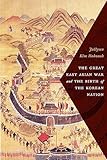The Great East Asian War and the Birth of the Korean Nation / JaHyun Kim Haboush; ed. by William Haboush, Jisoo Kim.
Material type: TextPublisher: New York, NY : Columbia University Press, [2016]Copyright date: ©2016Description: 1 online resource (240 p.)Content type:
TextPublisher: New York, NY : Columbia University Press, [2016]Copyright date: ©2016Description: 1 online resource (240 p.)Content type: - 9780231172288
- 9780231540988
- 951.9/02 23
- DS913.43 .H33 2016
- online - DeGruyter
- Issued also in print.
| Item type | Current library | Call number | URL | Status | Notes | Barcode | |
|---|---|---|---|---|---|---|---|
 eBook
eBook
|
Biblioteca "Angelicum" Pont. Univ. S.Tommaso d'Aquino Nuvola online | online - DeGruyter (Browse shelf(Opens below)) | Online access | Not for loan (Accesso limitato) | Accesso per gli utenti autorizzati / Access for authorized users | (dgr)9780231540988 |
Frontmatter -- CONTENTS -- FOREWORD -- Map of Choso˘n Korea -- INTRODUCTION -- 1 THE VOLUNTEER ARMY AND THE DISCOURSE OF NATION -- 2 THE VOLUNTEER ARMY AND THE EMERGENCE OF IMAGINED COMMUNITY -- 3 WAR OF WORDS: The Changing Nature of Literary Chinese in the Japanese Occupation -- 4 LANGUAGE STRATEGY: The Emergence of a Vernacular National Space -- 5 THE AFTERMATH: Dream Journeys and the Culture of Commemoration -- PUBLICATIONS OF JAHYUN KIM HABOUSH -- NOTES -- BIBLIOGRAPHY -- INDEX
restricted access online access with authorization star
http://purl.org/coar/access_right/c_16ec
The Imjin War (1592-1598) was a grueling conflict that wreaked havoc on the towns and villages of the Korean Peninsula. The involvement of Chinese, Japanese, and Korean forces, not to mention the regional scope of the war, was the largest the world had seen, and the memory dominated East Asian memory until World War II. Despite massive regional realignments, Korea's Chosôn Dynasty endured, but within its polity a new, national discourse began to emerge. Meant to inspire civilians to rise up against the Japanese army, this potent rhetoric conjured a unified Korea and intensified after the Manchu invasions of 1627 and 1636.By documenting this phenomenon, JaHyun Kim Haboush offers a compelling counternarrative to Western historiography, which ties Korea's idea of nation to the imported ideologies of modern colonialism. She instead elevates the formative role of the conflicts that defined the second half of the Chosôn Dynasty, which had transfigured the geopolitics of East Asia and introduced a national narrative key to Korea's survival. Re-creating the cultural and political passions that bound Chosôn society together during this period, Haboush reclaims the root story of solidarity that helped Korea thrive well into the modern era.
Issued also in print.
Mode of access: Internet via World Wide Web.
In English.
Description based on online resource; title from PDF title page (publisher's Web site, viewed 02. Mrz 2022)


